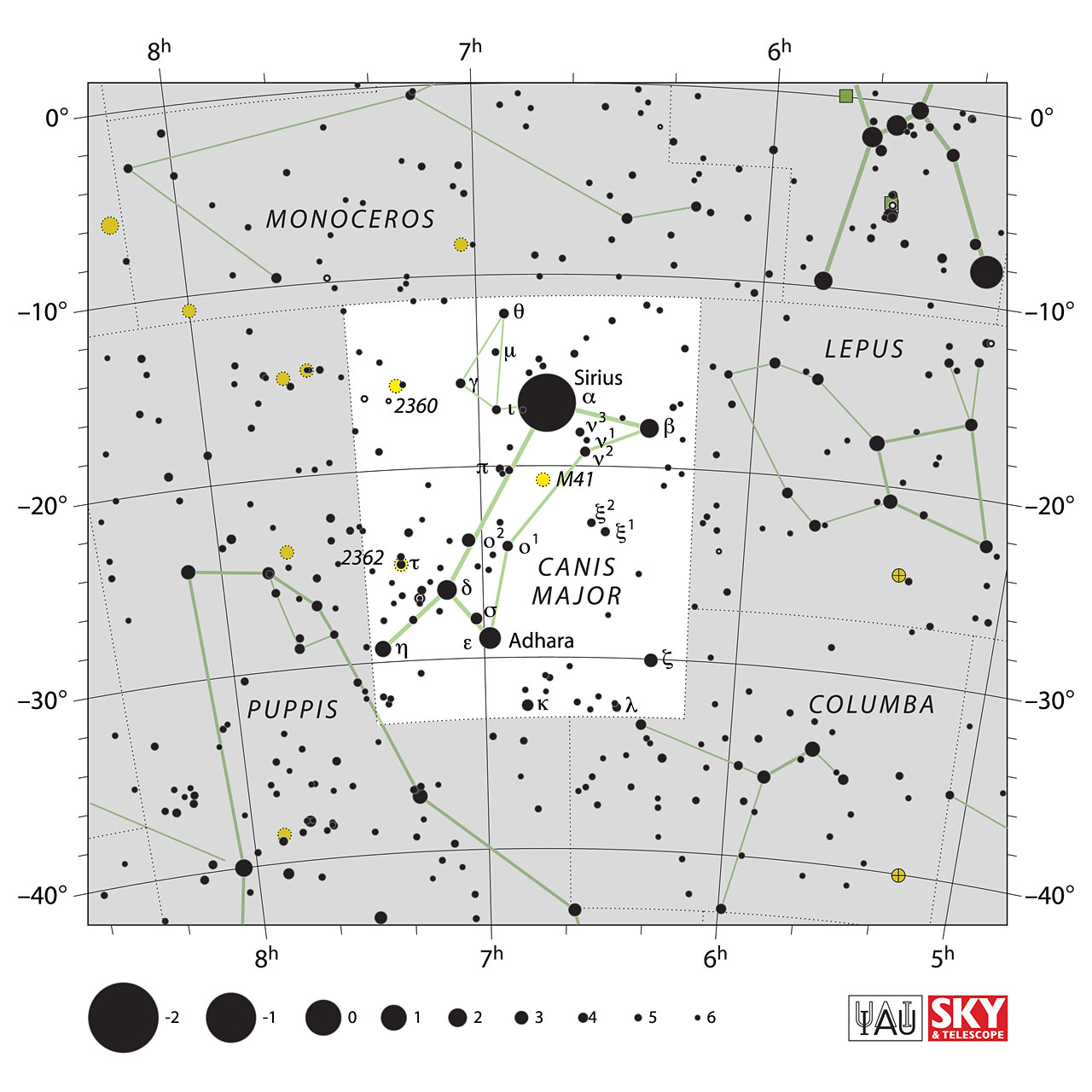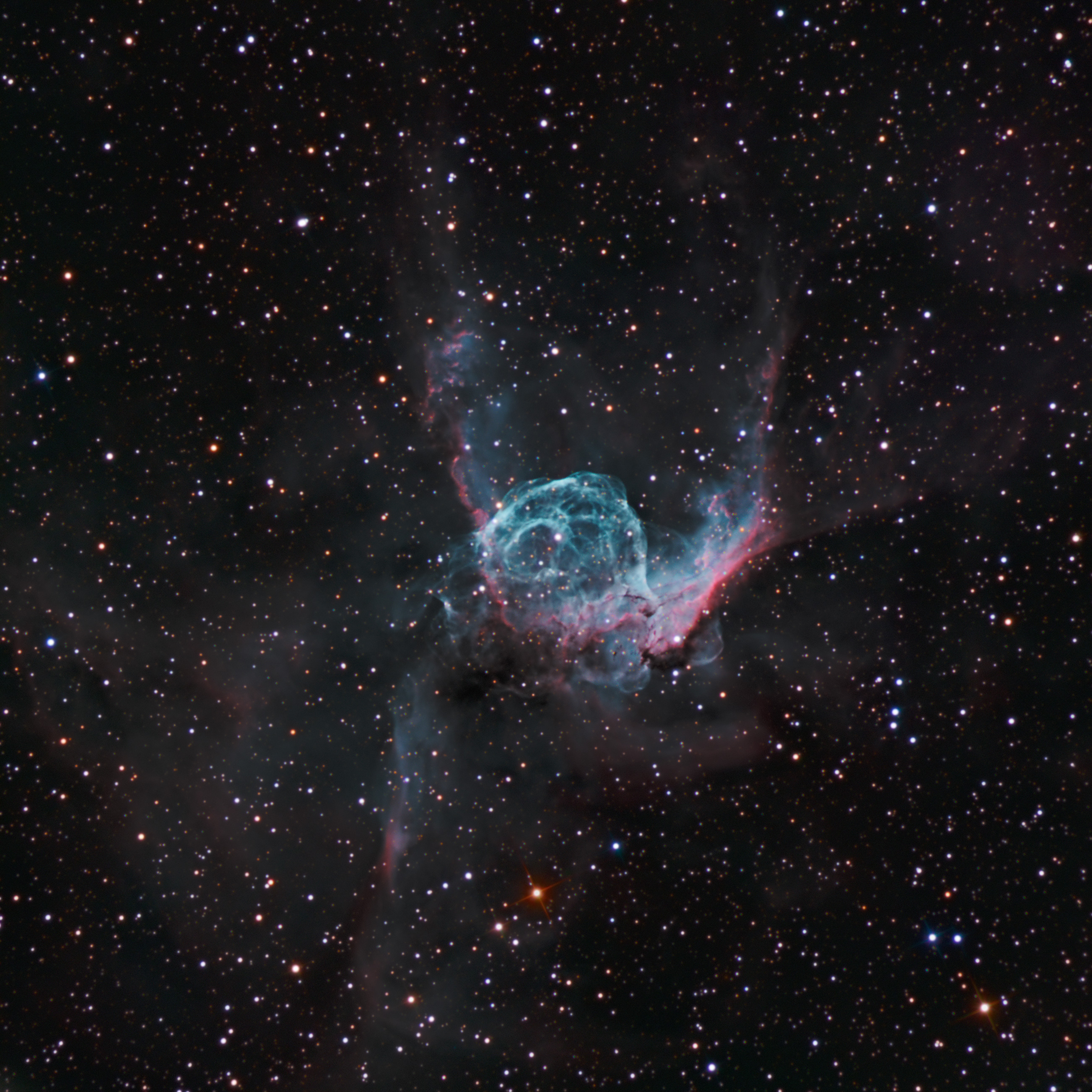
| Version | Summary | Created by | Modification | Content Size | Created at | Operation |
|---|---|---|---|---|---|---|
| 1 | Encyclopedia Editorial Office | -- | 1570 | 2024-02-29 06:42:48 |
Video Upload Options
Canis Major, Latin for "Greater Dog," is one of the most prominent constellations in the southern celestial hemisphere. Often depicted as one of Orion's hunting dogs in Greek mythology, Canis Major is best known for its brightest star, Sirius, also called the Dog Star, which is the brightest star in the night sky. With its distinctive shape and rich cultural significance, Canis Major has fascinated astronomers and storytellers throughout history.
1. Introduction
Canis Major, a constellation prominent in the southern celestial hemisphere, holds a significant place in both astronomical observation and cultural lore. Latin for "Greater Dog," Canis Major is one of the 88 recognized constellations, its celestial depiction rooted in ancient mythology and celestial navigation. Positioned near the celestial equator, Canis Major is observable from most locations on Earth, making it a familiar sight to stargazers across the globe.
The celestial coordinates of Canis Major place it between approximately 6 hours and 8 hours of right ascension and between -20 degrees and -60 degrees of declination. This positioning locates the constellation in close proximity to other notable celestial features, including the constellations Orion, Gemini, and Monoceros. Canis Major is particularly recognizable due to its association with Sirius, the brightest star in the night sky, which serves as the constellation's alpha star (Figure 1).
At the heart of Canis Major lies its most luminous feature, Sirius, also known as the Dog Star. With a visual magnitude of -1.46, Sirius outshines all other stars in the night sky, captivating observers with its brilliance and striking blue-white color. Sirius holds a prominent place in ancient mythology, serving as the faithful companion of Orion, the great hunter, in Greek lore. Its conspicuous presence in the winter sky has made it a celestial beacon for navigators and astronomers throughout history. In addition to Sirius, Canis Major is home to several other notable stars and deep-sky objects. Among these is Adhara, the second-brightest star in the constellation, which illuminates the southern celestial heavens with its blue-white radiance. Canis Major also contains several open star clusters, such as Messier 41, a dazzling cluster of young stars located near Sirius. These clusters provide astronomers with valuable insights into the formation and evolution of stars within our galaxy.

Figure 1. IAU chart of Canis Major. Source: https://www.iau.org/static/archives/images/screen/cma.jpg. Credit: IAU and Sky & Telescope. Reproduced under CC BY 4.0 license.
2. Historical Background and Mythology
In Greek mythology, Canis Major is often depicted as the faithful companion of Orion, the mighty hunter. According to legend, Canis Major represents the larger of Orion's two hunting dogs, the other being Canis Minor. The most prominent star in the constellation, Sirius, known as the Dog Star, is said to be the brightest jewel adorning the collar of this celestial hound. The bond between Orion and his loyal canine companions is immortalized in countless tales and artworks, symbolizing loyalty, strength, and the enduring bond between humans and animals.
The historical significance of Canis Major extends beyond mythology, playing a pivotal role in the development of astronomy and celestial navigation. Ancient civilizations, such as the Egyptians and the Greeks, revered Sirius as a harbinger of the annual flooding of the Nile River, associating its appearance with the cycle of life, death, and rebirth. The heliacal rising of Sirius, occurring just before dawn during the summer months, marked the beginning of the Egyptian New Year and held profound religious and cultural significance.
In addition to its mythological and cultural significance, Canis Major holds astronomical importance due to its celestial coordinates and prominent features. Situated between the constellations Monoceros and Puppis, Canis Major spans an area of approximately 380 square degrees in the night sky. Its celestial coordinates place it between 6h 00m and 8h 00m of right ascension and between −20° and −45° of declination, making it visible from most locations in the Southern Hemisphere and parts of the Northern Hemisphere.
3. Notable Stars
In the constellation Canis Major, several notable stars shine brightly, each contributing to the constellation's celestial beauty and scientific significance. Among these stars, one stands out as the brightest in the entire night sky, while others exhibit unique characteristics and historical importance.
3.1. Sirius (α Canis Majoris)
Sirius, designated α Canis Majoris, is the brightest star in the constellation Canis Major and the brightest star in the entire night sky. Its name, Sirius, is derived from the Greek word "Seirios," meaning "glowing" or "scorcher," reflecting its dazzling brilliance and prominent presence in the heavens. Located just 8.6 light-years away from Earth, Sirius is a close neighbor to our solar system and is easily visible to the naked eye, even in light-polluted urban areas.
Sirius is a binary star system, consisting of two stars: Sirius A and Sirius B. Sirius A, the primary star, is a main-sequence star of spectral type A1V, with a surface temperature of approximately 9,940 Kelvin. It is roughly twice the mass of the Sun and shines with a luminosity about 25 times greater than that of the Sun. Sirius A appears as a bright, white star in the night sky, captivating observers with its radiant glow. Sirius B, the companion star, is a white dwarf star that orbits Sirius A. It is significantly smaller and fainter than Sirius A, with a surface temperature of around 25,000 Kelvin. Despite its diminutive size, Sirius B is incredibly dense, with a mass comparable to that of the Sun packed into a volume roughly the size of Earth. The existence of Sirius B was first predicted by the German astronomer Friedrich Bessel in the 19th century and later confirmed through observations in the early 20th century. The presence of Sirius B has had a profound impact on our understanding of stellar evolution and the life cycles of stars. It provides a compelling example of the fate that awaits stars like Sirius A once they exhaust their nuclear fuel and evolve into white dwarfs. The discovery of Sirius B also played a crucial role in verifying Albert Einstein's theory of general relativity, as its gravitational influence on Sirius A causes subtle shifts in the latter's position over time.
3.2. Adhara (ε Canis Majoris)
Adhara is the second-brightest star in Canis Major and one of the brightest stars in the night sky. Located approximately 430 light-years away from Earth, Adhara shines with a visual magnitude of about 1.50. It is a blue supergiant star, much larger and hotter than the Sun, with a luminosity over 38,000 times that of the Sun. Adhara's name is derived from the Arabic word for "virgins," reflecting its association with celestial maidens in Arabian mythology.
Wezen (δ Canis Majoris): Wezen is another notable star in Canis Major, although it is less famous than Sirius and Adhara. It is a yellow hypergiant star located approximately 1,800 light-years away from Earth. Wezen shines with a visual magnitude of around 1.84 and is one of the largest and most luminous stars known, with a radius over 1,500 times that of the Sun. The name Wezen is derived from the Arabic word for "weight" or "burden," symbolizing the star's immense size and brightness.
Aludra (η Canis Majoris): Aludra is a blue supergiant star located approximately 3,000 light-years away from Earth. It is one of the most luminous stars known, with a visual magnitude of about 2.45. Aludra is part of the young open star cluster Collinder 121, which lies within Canis Major. The name Aludra is derived from the Arabic word for "the virgin," reflecting its association with celestial maidens in Arabian mythology.
Mirzam (β Canis Majoris): Mirzam is a blue-white giant star located approximately 500 light-years away from Earth. It shines with a visual magnitude of about 1.98 and is one of the brighter stars in Canis Major. Mirzam's name is derived from the Arabic word for "the announcer," as it heralds the appearance of Sirius, the Dog Star, in the night sky.
4. Deep-Sky Objects
Open Cluster NGC 2362: NGC 2362 is a young open star cluster located near the star Tau Canis Majoris. It is relatively young, with an estimated age of around 5 million years, and contains several dozen bright stars. The cluster is easily visible with binoculars or a small telescope and is a popular target for amateur astronomers.
Open Cluster Messier 41 (M41): Messier 41 is another open star cluster located in Canis Major. It is one of the brightest open clusters in the sky and is easily visible to the naked eye under dark skies. M41 contains around 100 stars and is estimated to be around 200 to 250 million years old. Its proximity to Sirius makes it a popular target for observation.
Galactic Cluster NGC 2204: NGC 2204 is a galactic cluster located in the northern part of Canis Major. It is a relatively compact cluster containing several hundred stars and is thought to be around 40 to 60 million years old. NGC 2204 is best observed with a moderate-sized telescope and is often overlooked compared to other deep-sky objects in the constellation.
Galactic Cluster NGC 2359 (Thor's Helmet Nebula): NGC 2359, also known as Thor's Helmet Nebula, is a large emission nebula located near the star Eta Canis Majoris. It is named for its resemblance to the helmet worn by the Norse god Thor. NGC 2359 is an active star-forming region, with young, hot stars ionizing the surrounding gas and causing it to glow brightly. While challenging to observe due to its low surface brightness, Thor's Helmet Nebula is a stunning sight in photographs and long-exposure images (Figure 2).

Figure 2. Thor’s Helmet Nebula (NGC 2359).Source: https://commons.wikimedia.org/wiki/File:NGC_2359.jpg. Credit: Martin Rusterholz in CXIELO, CC BY-SA 3.0, via Wikimedia Commons.




